The archaeological sites of the Inca Trail are one of the most fascinating networks of ruins found along the legendary Inca Trail to Machu Picchu.
This historic route, known as Qhapaq Ñan in Quechua, connects numerous archaeological sites built by the Inca civilization, blending ancient architecture, engineering, and spirituality with the breathtaking natural landscapes of the Peruvian Andes.
Each ruin along the trail tells a unique story about the empire’s brilliance, its connection to nature, and its sacred path leading to the mystical citadel of Machu Picchu.
The Historical Significance of the Inca Trail Archaeological Sites
The Inca Trail archaeological sites were more than mere resting points — they were vital nodes in a sophisticated network of communication, trade, and pilgrimage routes that spanned across the Inca Empire.
Built over 500 years ago during the reign of Emperor Pachacutec, the Inca Trail served religious, administrative, and military purposes.
Each archaeological site had a strategic and symbolic purpose:
- Strategic: They functioned as military checkpoints and administrative centers.
- Agricultural: Many contained terraces for farming, ensuring food supply for travelers.
- Religious: Some were sacred shrines dedicated to deities such as the sun (Inti) or the mountains (Apus).
Today, hiking the Inca Trail is not just an adventure but a spiritual and cultural journey that allows travelers to follow the same footsteps once taken by Inca nobles and priests on their sacred pilgrimage to Machu Picchu.
Inca Trail Archaeological Sites – 4-Day Route
The Classic Inca Trail typically takes four days to complete, covering approximately 43 kilometers (26 miles) from Km 82 near Ollantaytambo to the Sun Gate (Inti Punku) overlooking Machu Picchu. Along this journey, trekkers encounter several well-preserved
archaeological sites, each offering a glimpse into Inca history, architecture, and cosmology.
Let us explore the main archaeological sites along the Inca Trail, organized by day and location.
Day 1 – From Cusco to Wayllabamba
Kilometer 82 (Start Point)
The trail begins at Km 82, located near the village of Piskacucho at 2,700 meters above sea level. This starting point marks the beginning of the ancient pilgrimage route. The surrounding landscape introduces trekkers to traditional Andean villages, fertile valleys, and
Inca terraces are still used by local farmers today.

Llactapata (Patallacta)
The first significant Inca Trail archaeological site is Llactapata, also known as Patallacta. The name means “High Town” in Quechua, and the site is believed to have served as an agricultural and administrative hub for travelers heading to Machu Picchu.
Llactapata is distinguished by:
- Extensive agricultural terraces descend the mountainside.
- Residential structures built with finely cut stones.
- A strategic position overlooking the convergence of the Cusichaca and Urubamba rivers.
Archaeologists believe Llactapata played a key role in managing food production and controlling access to the Sacred Valley.
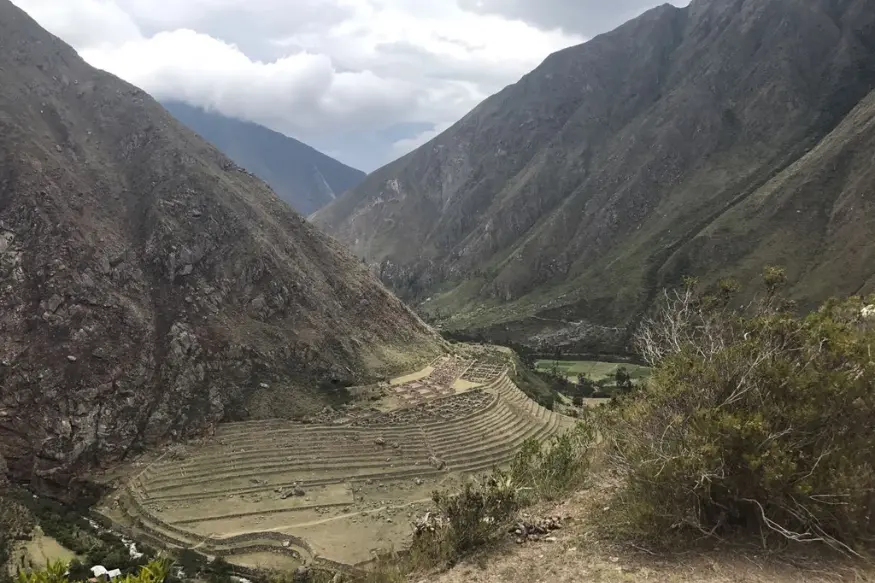
Wayllabamba (First Campsite)
Wayllabamba, meaning “grassy plain,” was an Inca village that offered rest and food for travelers. It sits at 3,000 meters and serves as the first campsite for modern trekkers. Though few visible ruins remain, its historical importance lies in its role as a crossroads
between valleys and ecological zones, symbolizing the Inca mastery of mountain adaptation.
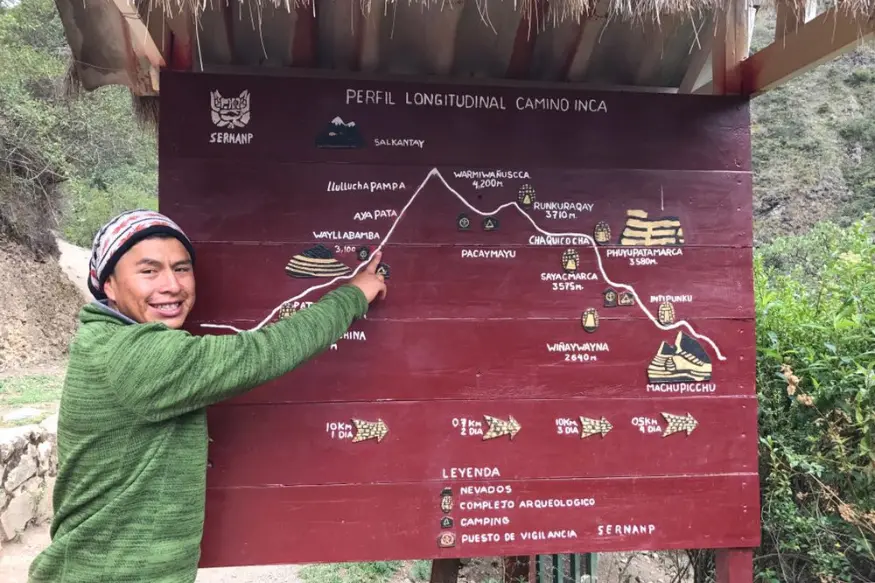

Day 2 – The Challenge of Dead Woman’s Pass
Llulluchapampa
On the ascent toward the highest point of the Inca Trail, hikers pass through Llulluchapampa, a scenic area surrounded by cloud forest vegetation and hummingbirds. While it does not contain major ruins, its landscape represents the spiritual connection the Incas
maintained with Pachamama (Mother Earth).

Warmiwañusca (Dead Woman’s Pass)
At 4,215 meters, Warmiwañusca, or “Dead Woman’s Pass,” is the highest point of the Inca Trail. Although it lacks built structures, the area has enormous symbolic significance. The Incas considered mountain passes sacred, believing they were portals connecting the
physical world (Kay Pacha) to the spiritual realm (Hanan Pacha). The breathtaking views and thin air make this section both a physical challenge and a moment of reflection for all travelers.
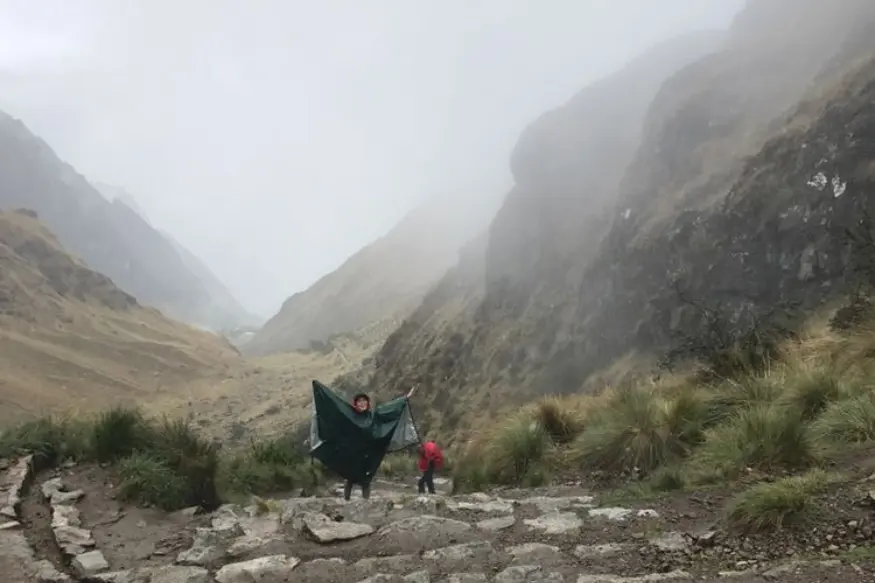
Pacaymayo Valley
Descending from Warmiwañusca, hikers reach the Pacaymayo Valley, a place where Inca travelers would rest and perform rituals to honor the mountains. Today, it serves as the second campsite and a gateway to some of the most impressive archaeological sites on the trail.
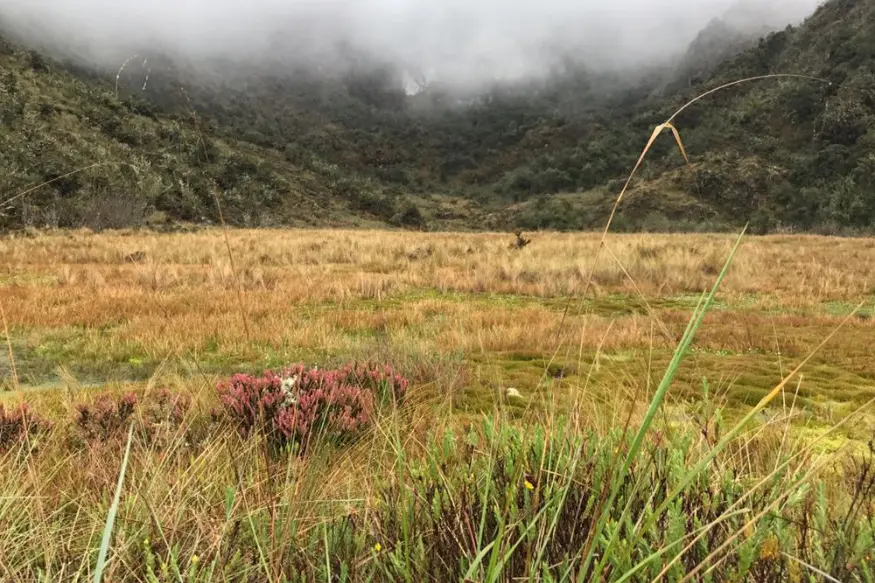
Day 3 – The Heart of the Inca Trail Ruins
Day three is often described as the most spectacular segment of the Inca Trail archaeological journey, as it includes multiple ruins connected by well-preserved stone staircases and cloud forest vistas.
Runkurakay
Runkurakay is a small circular ruin perched at 3,800 meters above sea level. Its semi-circular design is unique in Inca architecture and is believed to have been a tambo — a rest lodge or checkpoint for messengers (chasquis) and nobles.
Key features:
- Curved walls aligned with celestial points.
- Niches are used for storing ritual objects or food.
- Panoramic views of nearby valleys.
Runkurakay is a prime example of how the Incas harmonized construction with natural landscapes, symbolizing their philosophy of unity between humans and nature.
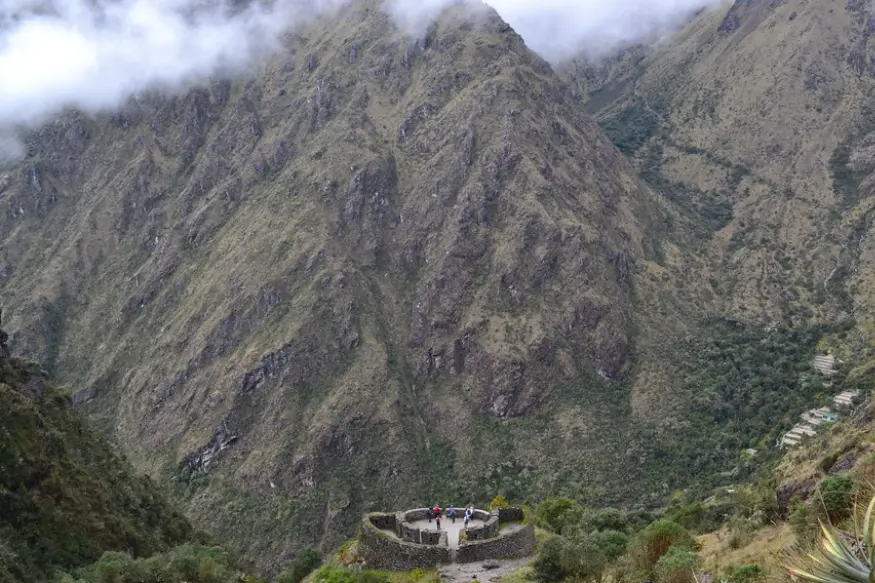
Sayacmarca
After crossing the Runkurakay Pass, trekkers reach Sayacmarca, meaning “Inaccessible Town.” This impressive ruin, built on a steep mountain ridge, is accessible only by a narrow stone staircase. It features a combination of ritual and residential structures, including:
- Temples and ceremonial platforms.
- Water channels and fountains.
- Stone stairways connecting terraces and observation points.
Sayacmarca served as both a spiritual and strategic lookout, offering stunning views of the Aobamba Valley. Its inaccessibility may have also served a defensive function during Inca times.
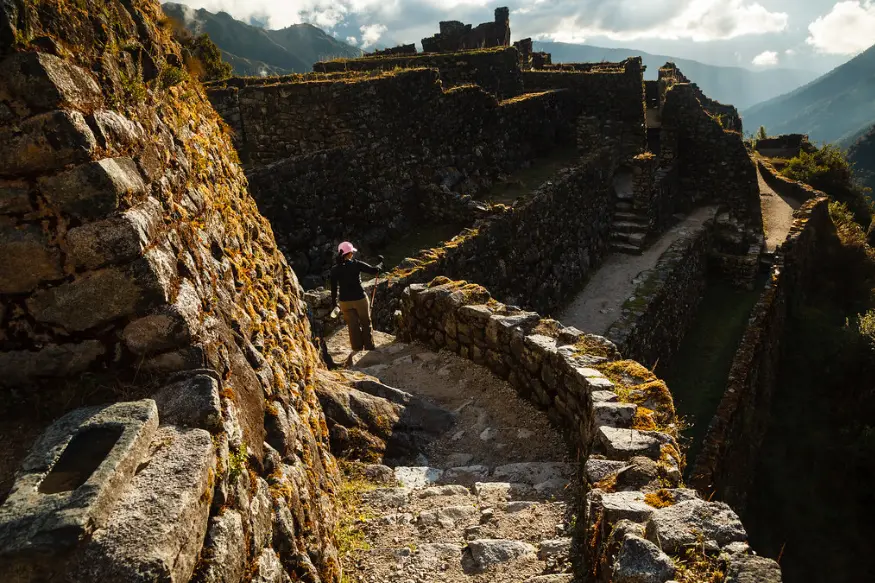
Phuyupatamarca
Translating to “Town Above the Clouds,” Phuyupatamarca is one of the most remarkable Inca Trail archaeological sites. It sits at 3,650 meters, often enveloped in mist, giving it a mystical aura.
This complex features:
- Ceremonial baths and ritual fountains.
- Terraced farming areas.
- Astrological observation platforms aligned with solstices.
Phuyupatamarca likely served as a place for purification ceremonies before entering the sacred city of Machu Picchu, emphasizing the spiritual transformation inherent in the pilgrimage.

Day 4 – The Final Descent to Machu Picchu
Wiñay Wayna
The last major ruin before Machu Picchu is Wiñay Wayna, meaning “Forever Young” in Quechua. This is one of the most beautiful and extensive archaeological sites along the Inca Trail, located at an elevation of 2,650 meters.
Wiñay Wayna showcases the quintessential Inca architectural genius:
- Steep terraces: Over 40 agricultural terraces cascade down the hillside.
- Ceremonial fountains: Water channels still flow today, symbolizing renewal and life.
- Residential areas: Carefully aligned houses and stairways demonstrate advanced urban planning.
Historians believe Wiñay Wayna was both a ceremonial and agricultural center used to prepare pilgrims spiritually before reaching Machu Picchu.

Inti Punku (The Sun Gate)
The Sun Gate, or Inti Punku, marks the grand finale of the Inca Trail archaeological sites. This monumental stone gateway served as the main ceremonial entrance to Machu Picchu. Positioned perfectly to frame the rising sun over the citadel during the solstices, Inti Punku represents the culmination of the Inca pilgrimage.
From this point, trekkers get their first glimpse of Machu Picchu, a view that remains one of the most emotional and rewarding moments of the journey.
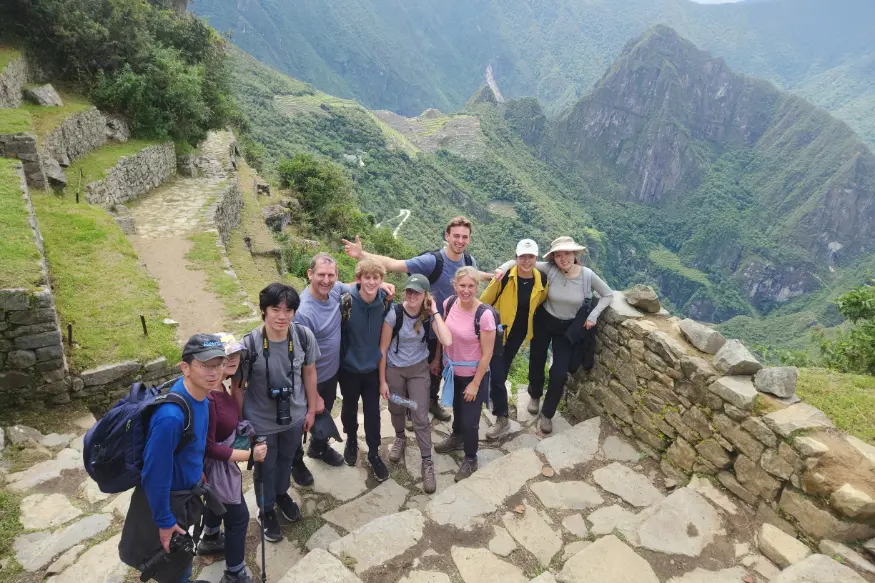
Machu Picchu Sanctuary
The journey along the Inca Trail reaches its sacred destination at Machu Picchu, the most iconic archaeological sanctuary of the Inca Empire. Hidden among the mountains at 2,430 meters, this UNESCO World Heritage Site represents the spiritual and architectural pinnacle of Inca civilization.
Explorers enter the citadel after passing through the Sun Gate, following the same path once taken by priests, astronomers, and nobles more than 500 years ago. Inside the sanctuary, visitors discover the Temple of the Sun, the Intihuatana (Sun Clock), the Temple of the Condor, and dozens of finely carved stone structures aligned with celestial events.
Machu Picchu is not only an engineering marvel but also a cosmic temple that unites heaven and earth. For the Incas, it was a place of connection between the human world (Kay Pacha) and the divine realm (Hanan Pacha). For modern travelers, it remains a symbol of mystery, discovery, and the eternal legacy of the Andean spirit.
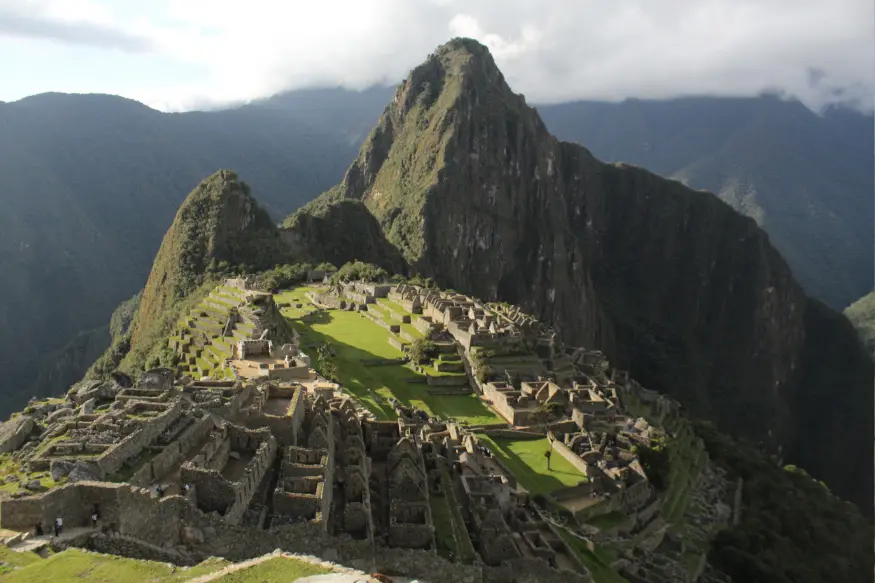
Inca Trail Archaeological Sites – 2-Day Route
Day 1 – From Cusco to Wiñay Wayna
Starting Point: Cusco – Ollantaytambo – Km 104
The 2-Day Inca Trail begins with an early transfer from Cusco to Ollantaytambo, followed by a scenic train ride to Kilometer 104, the official starting point. After crossing a small bridge over the Urubamba River, the hike officially begins — a shorter but equally magical route.

Chachabamba
The first archaeological site, Chachabamba, lies just after the control gate. It consists of altars, fountains, and ceremonial platforms dedicated to the worship of water and fertility. The site was likely used for ritual cleansing before entering sacred territory.

Wiñay Wayna
Continuing uphill through lush vegetation, trekkers reach the magnificent Wiñay Wayna, the most impressive ruin on the short Inca Trail.
Its name means “Forever Young,” symbolizing eternal life.
More than 40 terraces stretch along the mountain.
Stone stairways connect residential and ceremonial areas.
Water channels still flow through ritual baths and fountains.
Wiñay Wayna was a spiritual stop for pilgrims preparing to reach Machu Picchu, where purification and meditation took place before entering the sanctuary.
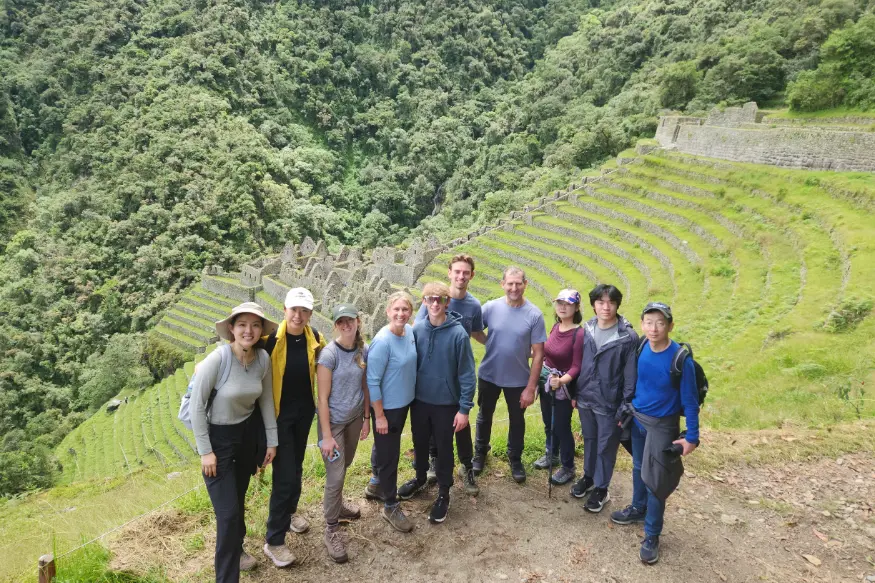
Day 2 – Arrival at the Sacred City of Machu Picchu
Inti Punku (The Sun Gate)
The second day begins early with a steady ascent through the misty cloud forest toward Inti Punku, the Sun Gate.
This iconic stone structure offers the first unforgettable view of Machu Picchu, as the morning sunlight slowly reveals the citadel below. The moment feels timeless, echoing the emotions of ancient pilgrims who first witnessed the same view centuries ago.
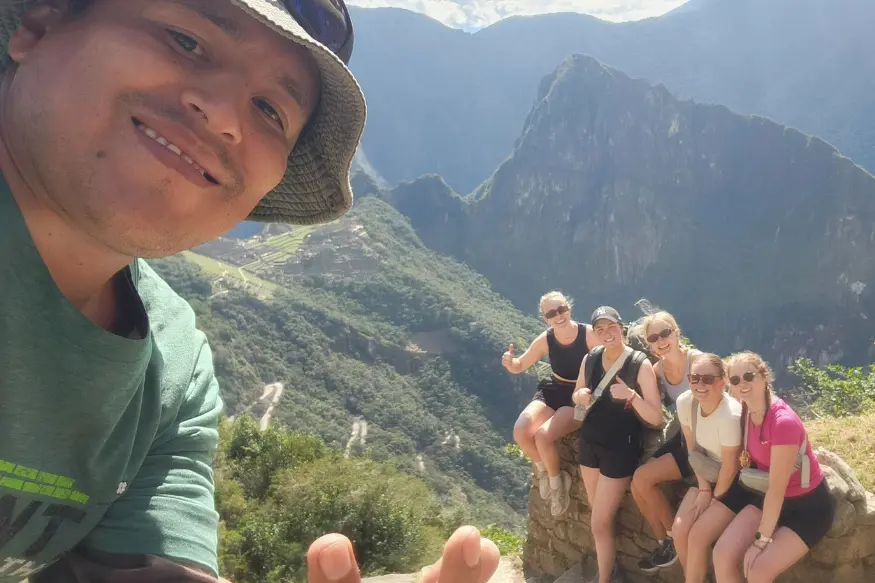
Machu Picchu Sanctuary
After passing through Inti Punku, travelers descend to the heart of the Machu Picchu Sanctuary, exploring the temples, terraces, and plazas of this extraordinary site.
Highlights include the Temple of the Sun, Royal Tomb, Sacred Plaza, and the Intihuatana, where the Incas tracked celestial movements.
The short trail may take only two days, but it encapsulates the full spiritual essence and grandeur of the Inca civilization.

The Architectural Marvel of the Inca Trail Sites
The Inca Trail archaeological sites display the architectural ingenuity of the Inca civilization. Key characteristics include:
- Perfect stone masonry: Stones were cut and fitted without mortar.
- Terracing: Engineered for both agriculture and erosion control.
- Water systems: Sophisticated canals and fountains used for irrigation and rituals.
- Astronomical alignment: Temples and windows aligned with solar events like solstices and equinoxes.
These elements reveal the Incas’ deep understanding of astronomy, hydrology, and engineering — as well as their profound respect for nature.
Religious and Cultural Importance
The Inca Trail was not simply a road but a spiritual journey. Pilgrims followed this path as part of rituals dedicated to the sun god (Inti) and the sacred mountains. The ruins along the route were ceremonial stations where offerings were made and purification rites performed before reaching Machu Picchu — considered the “spiritual center of the world.”
Today, modern trekkers experience echoes of this sacred pilgrimage, walking through the same landscapes and feeling the same connection between earth, sky, and spirit that inspired the Inca people centuries ago.
Preservation and Modern Exploration
Preserving the Inca Trail archaeological sites is a collaborative effort involving the Peruvian government, archaeologists, and local communities. Due to its popularity, access is regulated:
- Only 500 people (including guides and porters) are allowed to start the trail per day.
- A licensed guide and official permit are required.
- The trail closes every February for conservation work.
Ongoing restoration ensures that future generations can continue to experience these ancient wonders while maintaining their historical integrity.
